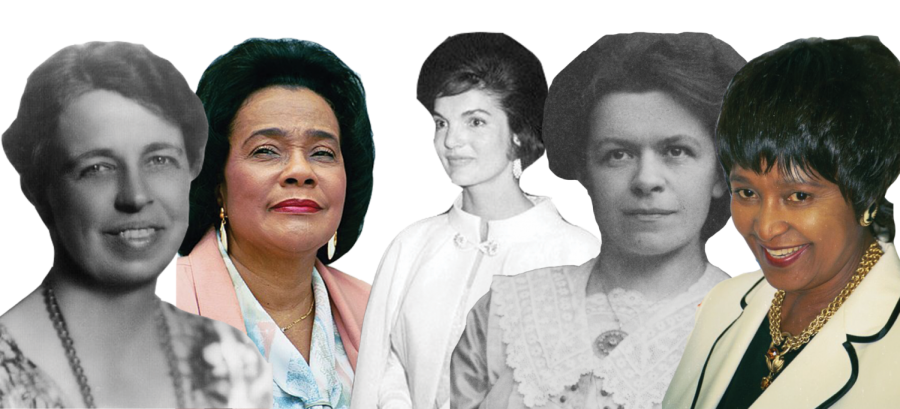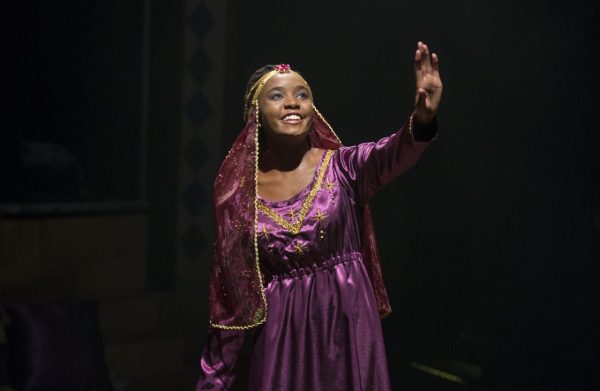Not just a wife: celebrating the women behind famous men
I’m tired of the expression, “Behind every great man there is a woman.”
We’ve heard all of the cliches before, “behind every great man there’s a woman rolling her eyes,” or “behind every great man there is a woman keeping him in line.” We’ve seen all of the classic depictions of women being referred to as the persistent and lingering wife or the intefering mother.
But believe it or not, there’s a different way we should look at the women that are “behind every great man,” more than just referring to them as wives of great men. So many of these women are overshadowed by a man’s representation and sadly, it’s quite exhausted through history.
There’s a reason so many amazing women are concealed of their accomplishments and misrepresented through society, a reason that DePaul professor of English, Michele Morano can explain. “You’re right that great men often have strong women behind them,” she said. “Traditional gender roles -–with men working in the public sector while women worked in the private sector as mothers, wives, homemakers – meant fewer opportunities for women to pursue art, literature, science, etc.”
All of these women have accomplishments and journeys of their own, ones that should stand out and stand aside from the men in their lives and their own successes. Often these women have reached to greater levels of accomplishments than their male companions whose names and images are remembered and mentioned more emphatically than her own through history. We can’t keep these women placed on a mantle behind their husbands, but we should bring them forth, ride alongside where they should be.
As National Women’s History month kicks off, here is a little tribute to the great women who shouldn’t be placed behind their great men, but alongside, front and center.
Jackie Kennedy, also known as “Jackie O” is one of the most well-known first ladies. Although Jackie presumed the title as “the first lady” and is known for being the wife of the 35th president of the United States, John F. Kennedy, she was an impressive self-made woman.
After attending Vassar University, the Sorbonne, and George Washington University, Jackie O’s first job was working as a reporter for the Washington Times-Herald in 1952 where she was the paper’s “Inquiring Photographer.” Just like any other reporter, she was traveling the streets of D.C. asking strangers for their opinions on everything from politics all the way to personal relationships. She was even heard asking the question, “Do you think a wife should let her husband think he’s smarter than she is?”
On top of being a fashionable trendsetter, a fluent speaker of Spanish, French, and Italian, a successful and avid book editor, she even opened up a school inside the White House.
Right up on the mantle next to the other women who were placed behind their great men is Coretta Scott King. Known as the “First Lady of the Civil Rights movement” and wife of Martin Luther King Jr., King worked with her husband all throughout his life and even took up his platform after his assassination.
Many people acknowledge Coretta’s accomplishments alongside those of her husband, as powerful, impactful, and beautiful – as they should. But Coretta on her own is a woman that deserves the utmost recognition for her committed activism and fight for the oppressed and underrepresented people in the world. Yes she was a mother, wife, a civil rights activist and organizer but she was also so much more than we commonly know about.
She was a singer, a violinist, an early protestor of the Vietnam War and Apartheid, as well as a world traveler and a proponent of gay rights. We look back and think of her and see her great husband come up in our minds, but Coretta Scott King should never be a woman who is affiliated standing behind her husband.
Right next to Coretta Scott King and Jackie O are a bunch of other amazing women who are often underrepresented and stuck in the shadows behind the great men in their lives.
Eleanor Roosevelt was the first presidential spouse to hold press conferences as well as speak at a national convention. Although assuming the role of the first lady, she was in fact outspoken and often openly disagreed with some of her husband’s policies and views. She worked with the Red Cross during the first world war as well as the Women’s Trade Union League, fighting for the 48-hour work week, minimum wage as well as the riddance of child labor.
Winnie Mandela was named the “Mother of the Nation” as she held on to her strong presence during the apartheid conflict. At one point during her activism, she was detained, tortured, and placed under house arrest and kept in solitary confinement.
Mileva Einstein- Maric herself was also an accomplished physicist, but after the birth of her and Albert Einstein’s children she was constricted of her lifetime work. But although her research was cut short, she can be credited for much of Einstein’s work as well.
These women are all connected to accomplished, respected, and remembered men, but let us not forget all of their own astonishing successes. Although women in history are often forgotten about or overshadowed by the successes of their husbands, there have been waves of feminism that have allowed powerful women to shine and take their seat front in center alongside their husbands.
DePaul associate professor of history and art, Joanna Gardner-Huggett further explained how waves of feminism have allowed women, especially women artists and historians to obtain the acknowledgment of their successes. “Thanks to the feminist discourses taking hold in the late 1960s, artists, curators, historians and critics began to challenge the art world’s misogyny,” she said. “Feminists not only engaged in activism, but mentored the next generations of female artists, curators, and historians. The continued intergenerational dialogue among feminists, and mentoring, is essential to the increased number of successful female artists and leadership of women in museums and the art world more broadly.”
Lauren Lewis, a second year student at DePaul agrees with Gardner- Huggett. “I think that the original first wave feminists were the ones to push women out of the “trophy wife” ideas,” she said. “I think women today are inspired by countless strong women who have pushed to be where they are now. I also think women today are inspired by the idea of creating a better future for themselves and the women to come after us.”
It’s from these waves of feminism and historically acknowledged women that today we can recognize the inspirational and hard-working female figures such as Ruth Bader Ginsburg, Michelle Obama, and Alexandria Ocasio-Cortez.
Where there is a man, there might be a woman. But where there is a great woman, there doesn’t have to be a man alongside her overshadowing all of her triumphs and impacts on our society.













Joe Moceri • Jul 27, 2020 at 11:19 pm
One that I think you missed was Abigale Adams. Wife of the second president to these States United.